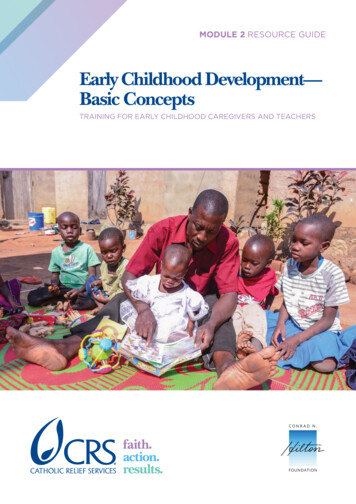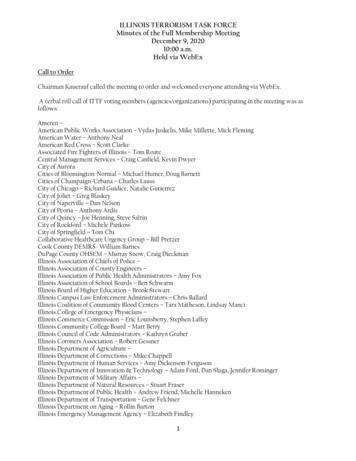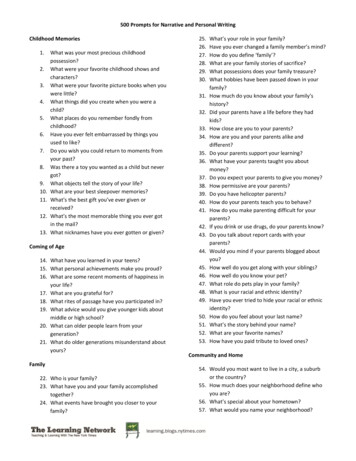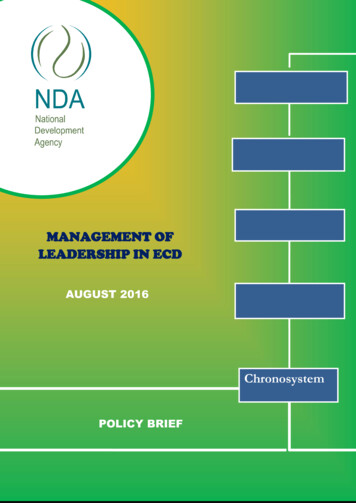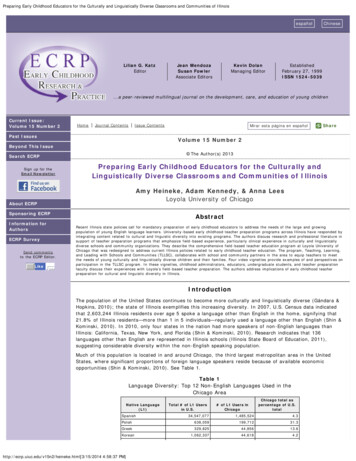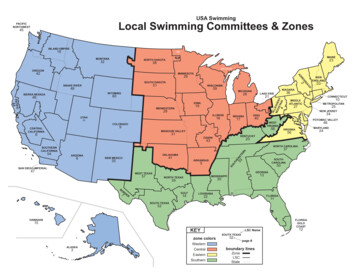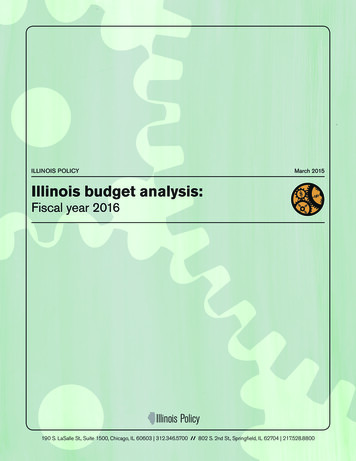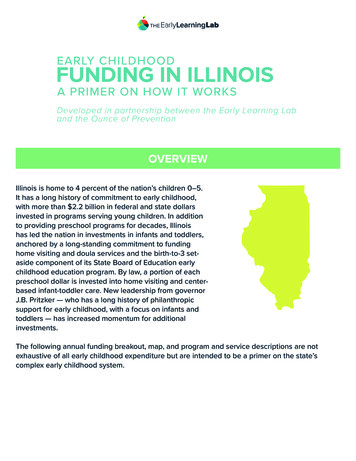
Transcription
OVERVIEWIllinois is home to 4 percent of the nation’s children 0–5.It has a long history of commitment to early childhood,with more than 2.2 billion in federal and state dollarsinvested in programs serving young children. In additionto providing preschool programs for decades, Illinoishas led the nation in investments in infants and toddlers,anchored by a long-standing commitment to fundinghome visiting and doula services and the birth-to-3 setaside component of its State Board of Education earlychildhood education program. By law, a portion of eachpreschool dollar is invested into home visiting and centerbased infant-toddler care. New leadership from governorJ.B. Pritzker — who has a long history of philanthropicsupport for early childhood, with a focus on infants andtoddlers — has increased momentum for additionalinvestments.The following annual funding breakout, map, and program and service descriptions are notexhaustive of all early childhood expenditure but are intended to be a primer on the state’scomplex early childhood system.
ANNUAL EARLY CHILDHOOD FUNDING BREAKOUT*PREVENTION INITIATIVE INCLUDES CENTER-BASED CARE AND HOME VISITING.**BUDGET DATA FOR CHILDREN 0-5 IS NOT AVAILABLE.
MAP OF ILLINOIS’ EARLY CHILDHOOD FUNDING
TYPES OF PROGRAM & SERVICE DESCRIPTIONSHEAD STARTHEAD START (HS),EARLY HEAD START (EHS), EARLY HEAD START CHILD CAREPARTNERSHIPS, MIGRANT AND SEASONAL HEAD STARTWhat is the program/service?Head Start is a program of the United States Department of Health and Human Services thatprovides comprehensive early childhood education, health, nutrition, and parent involvementservices to low-income children from birth to age 5 and their families. Many Head Start programsalso provide Early Head Start (EHS), which is a comprehensive child development programfor low-income pregnant women, infants, and toddlers (from birth through 2), including youngchildren with disabilities. Illinois also has Migrant and Seasonal Head Start as well as Early HeadStart Child Care Partnerships.Who is the provider?K–12 schools, operators of community-based early childhood centers, some family childcarehomes, and child and family support entities.How much funding is there and what is it for? 347.6 (FY17)Head Start funds are awarded directly to eligible program operators at the local level. Operatorscan use contract funds for a wide range of program expenses including operations, professionaldevelopment, quality improvement, and investments in technology. Additional grants forprofessional development are also included in grants and may be used for technology as well.Regional technical assistance centers receive separate funding and may choose to leveragetechnology.Who benefits?44,000 children were served in Head Start and Early Head Start (FY18).PRESCHOOL FOR ALL AND PREVENTION INITIATIVEWhat is the program/service?Preschool for All (PFA) is a birth-to-5 funding stream that includes preschool, home visiting, andcenter-based infant-toddler care. PFA provides preschool programming for 3- and 4-year-olds,with an enrollment priority for children who have risk factors for school success. This fundingcovers the Prevention Initiative (PI), which funds home visiting and center-based services forinfants and toddlers from families with risk factors.
Who is the provider?PFA: School-based early childhood centers in K–12 schools and operators of community-basedearly childhood centers.PI: Operators of community-based early childhood centers and child and family support entities.Some of these services are provided in the child’s home.How much funding is there and what is it for? 493.7 million (FY19)Operators and individuals can use contract funds for a wide range of program expenses includingoperations, professional development, quality improvement, and investments in technology.Who benefits?89,000 children 0–5 years of age benefit from these services, including 75,000 in the PFAprogram and 13,700 infants and toddlers in the PI program (FY18).TITLE I PRESCHOOLWhat is the program/service?K–12 schools and other local education agencies (LEAs) with a concentration of low-incomechildren receive targeted funds under Part A (Title I) of the Every Student Succeeds Act (ESEA),which provides financial assistance to help ensure that all children meet challenging stateacademic standards. Title 1 funds may be used by LEAs to fund early childhood education programsfor eligible children that are subject to the performance standards of the Head Start Act.Who is the provider?K–12 schools.How much funding is there and what is it for?Data on the amount of Title 1 funds allocated to preschool and early childhood programs is notavailable.School districts have flexibility in how they spend their Title 1 funds to help ensure all childrenare able to meet academic standards; the wide range of program expenses includes operations,professional development, quality improvement, and investments in technology.Who benefits?Data on numbers of children served not available.
CHILD CARE ASSISTANCE PROGRAM (CCAP)What is the program/service?The Child Care Assistance Program (CCAP) provides childcare subsidies to low-income workingfamilies and those engaged in education or training activities to pay for childcare. The CCAPfunds are a mix of state general funds, federal Temporary Assistance to Needy Families (TANF),and federal Child Care Development Fund (CCDF) and Child Care Development Block Grant(CCDBG) funding.Who is the provider?K–12 schools, operators of community-based early childhood centers, family childcare homes,and family, friends, and neighbors.How much funding is there and what is it for? 1.2 billion total (FY19) including 403 million in state general funds, 291 million in CCDF funds, 485 million from TANF, and 5.2 million of other federal funds for a wage supplement program.This funding is used to issue payments to the childcare provider, with some funding set asidefor administering agencies’ overhead costs. Operators and individuals that accept childrenwith subsidies can use funds for a wide range of expenses including operations, professionaldevelopment, quality improvement, and investments in technology. These funds also supportchildcare resource and referral services, provider quality enhancements, and workforcedevelopment initiatives.Who benefits?121,000 children 0–5 average monthly enrollment (FY18).SPECIAL EDUCATIONEARLY INTERVENTION, EARLY CHILDHOOD SPECIAL EDUCATIONWhat is the program/service?Illinois’ Early Intervention (EI) program provides resources and supports to infants and toddlers,from birth to 3, with diagnosed disabilities or developmental issues. Early Childhood SpecialEducation (ECSE) serves children 3 through 5 years of age and their families.Both programs are funded through a combination of state funds and federal funding through theIndividuals with Disabilities Education Act (IDEA) — Early Intervention through IDEA Part C andEarly Childhood Special Education through IDEA Part B.
Who is the provider?K–12 schools, operators of community-based early childhood centers, child and family supportentities, and hospitals and clinics.How much funding is there and what is it for? 306 million in total funding (FY19); 276.7 million for the Early Intervention program, including 97.6 million in State General Fund and a 180 million fund to disburse payments from familyfees, insurance company payments, federal Medicaid reimbursements, and state funds; 29.2million for Early Childhood Special Education funded from IDEA Part B (FY19).Funding can pay for assistive technology for children. Other service delivery funds may be spenton operations, professional development, and technology. Preschool special education servicesunder IDEA Part B are generally subject to greater strictures in allowable expenditures than IDEAPart C services for infants and toddlers.Who benefits?122,000 infants and toddlers are served in the EI program (FY18) and 37,000 children 3–5 yearsof age through the ECSE (2017–2018 school year).HOME VISITINGWhat is the program/service?Home visiting programs in Illinois are funded through the federal Maternal Infant Early ChildhoodHome Visiting Program (MIECHV) and two budget lines in the state Department of HumanServices (DHS) Budget, offering evidence-based home visiting programs and parent coachingsupport to expecting and new parents who are at risk for poor health, educational, economic,and social outcomes. (Prevention Initiatives funds in the Early Childhood Block Grant at the StateBoard of Education also pay for home visiting but are included in the Early Childhood Block Grantsection above.)Who is the provider?Child and family support entities and hospitals and clinics. Services are generally provided in thechild’s home.How much funding is there and what is it for? 25 million including 16.9 million for DHS Home Visiting (FY19) and approximately 8 million forMIECHV funded services (FY18).Operators that provide home visitation services can use contract funds for a wide range ofprogram expenses including operations, professional development, quality improvement, andinvestments in technology.
Who benefits?2,900 families are served through DHS (FY18), and 900 families are served per year withMIECHV-funded services.NUTRITION PROGRAM FOR WOMEN, INFANTS, AND CHILDREN (WIC)ILLINOIS SPECIAL SUPPLEMENTAL NUTRITION PROGRAM FOR WOMEN, INFANTS,AND CHILDREN (WIC)What is the program/service?The Special Supplemental Nutrition Program for Women, Infants, and Children (WIC) is a federallyfunded health and nutrition program that provides supplemental foods, nutrition education, andreferrals to health care to low-income pregnant, breastfeeding, and postpartum women, infants,and children up to age 5 who are determined to be at nutritional risk.Who is the provider?Community-based early childhood centers, K–12 schools, hospitals and clinics including migranthealth centers and camps, Indian health service facilities, county health departments, and childand family support entities including community centers and public housing.How much funding is there and what is it for? 290.5 million (FY19)WIC funds go to state agencies to operate the program. Funds are used for a variety of purposesincluding food acquisition by participants as well as funds for eligible services. Some funds maybe used for program operation including technology.Who benefits?100,700 infants and children and 33,000 pregnant or postpartum women (2018 state report toUSDA).MEDICAID AND CHILDREN’S HEALTH INSURANCE PROGRAMALL KIDS PROGRAMWhat is the program/service?Medicaid and Early and Periodic Screening, Diagnostic and Treatment (EPSDT): Medicaidprovides health coverage to eligible low-income adults, children, pregnant women, elderlyadults, and people with disabilities. Medicaid is administered by states, according to federal
requirements. The program is funded jointly by states and the federal government. In Illinois,Medicaid coverage for children is provided through the All Kids Program.Children’s Health Insurance Program (CHIP): The Children’s Health Insurance Program(CHIP) serves uninsured children up to age 19 in families with incomes too high to qualify themfor Medicaid. States have broad discretion in setting their income eligibility standards, andeligibility varies across states. In Illinois, the All Kids Program offers many of Illinois’ childrencomprehensive health care that includes doctors’ visits, hospital stays, prescription drugs, visioncare, dental care, and medical devices like eyeglasses and asthma inhalers.Who is the provider?Hospitals and clinics as well as child and family support entities.How much funding is there and what is it for?All Kids expenditure for FY18 for children 0–5 was 1.06 billion dollars.Subject to applicable statutes and regulations, these funding streams can cover a range ofservices, and a variety of technologies are used for the diagnosis and treatment of patients.Who benefits?Data on numbers of children 0–5 served not available.This report was made possible by the generous support from Omidyar Network.Published in December 2019. 2019 The Early Learning Lab. All Rights Reserved.
Illinois is home to 4 percent of the nation’s children 0–5. It has a long history of commitment to early childhood, with more than 2.2 billion in federal and state dollars invested in programs serving young children. In addition to providing preschool programs for decades, Illinois h

